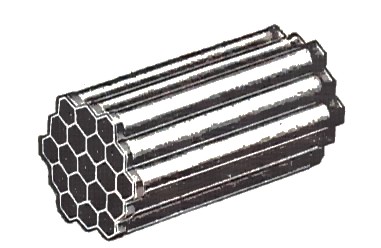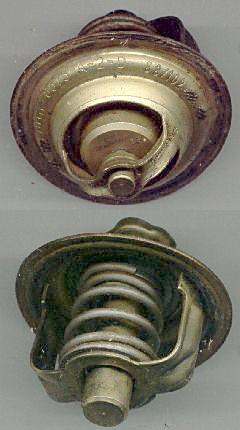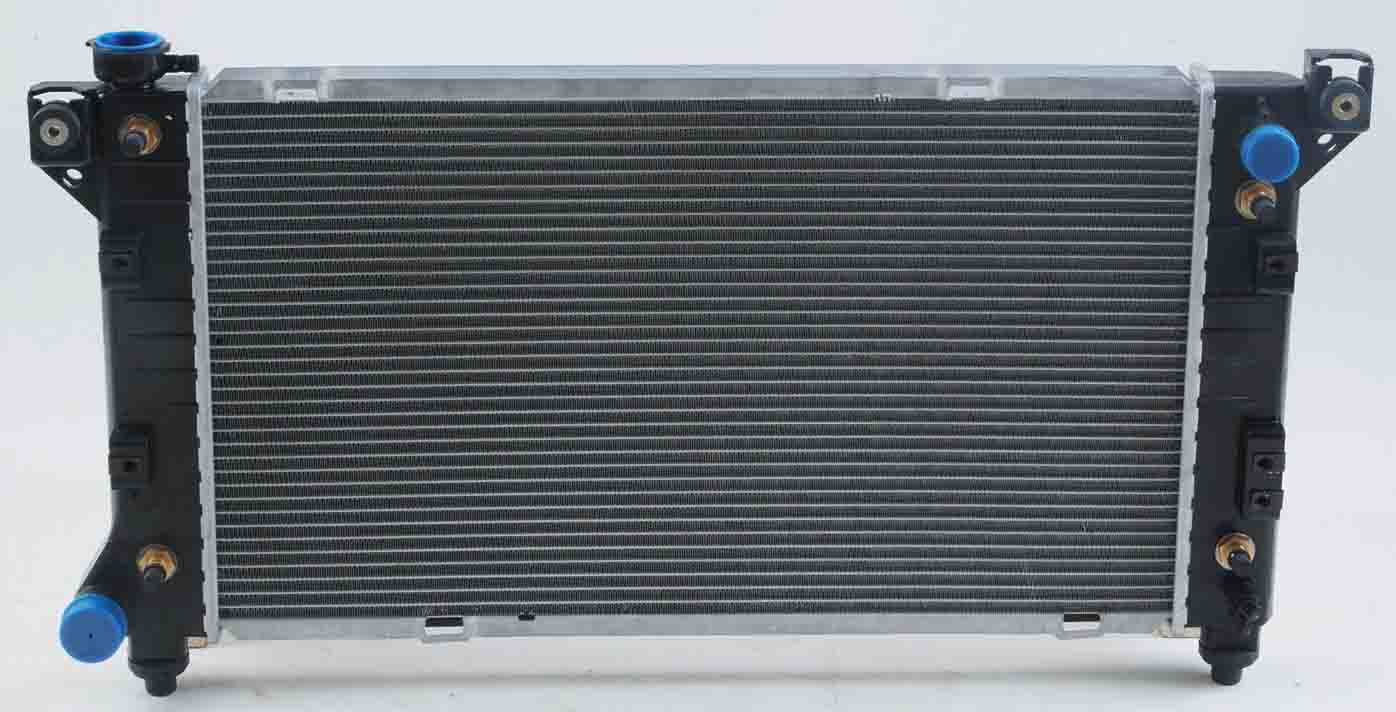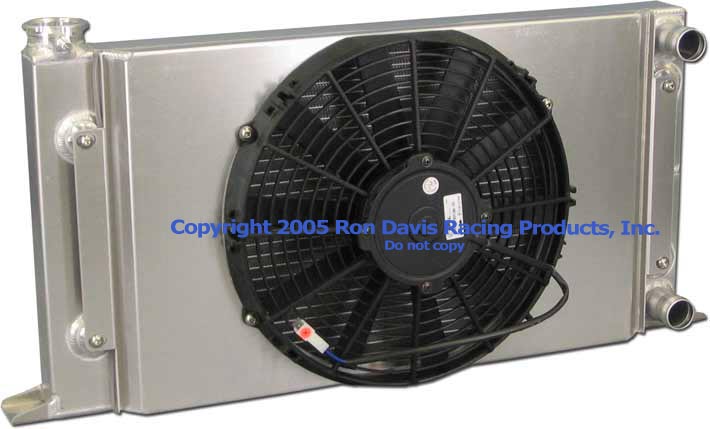Radiators are heat exchangers used to transfer thermal energy from one medium to another for the purpose of cooling and heating. The majority of radiators are constructed to function in automobiles, buildings, and electronics. The radiator is always a source of heat to its environment, although this may be for either the purpose of heating this environment, or for cooling the fluid orcoolant supplied to it, as for engine cooling.
The heating radiator was invented by Franz San Galli, a Polish-born Russian businessman living inSt. Petersburg, between 1855-1857.

In automobiles with a liquid-cooled internal combustion engine a radiator is connected to channels running through the engine and cylinder head, through which a liquid (coolant) is pumped. This liquid may be water (in climates where water is unlikely to freeze), but is more commonly a mixture of water and antifreeze in proportions appropriate to the climate. Antifreeze itself is usually ethylene glycol or propylene glycol (with a small amount of corrosion inhibitor).
The radiator transfers the heat from the fluid inside to the air outside, thereby cooling the engine. Radiators are also often used to cool automatic transmissions, air conditioners, and sometimes to cool engine oil. Radiators are typically mounted in a position where they receive airflow from the forward movement of the vehicle, such as behind a front grill. Where engines are mid- or rear-mounted, it is common to mount the radiator behind a front grill to achieve sufficient airflow, even though this requires long coolant pipes. Alternatively, the radiator may draw air from the flow over the top of the vehicle or from a side-mounted grill. For long vehicles, such as buses, side airflow is most common for engine and transmission cooling and top airflow most common for air conditioner cooling.
Radiator construction
Automobile radiators are constructed of a pair of header tanks, linked by a core with many narrow passageways, thus a high surface area relative to its volume. This core is usually made of stacked layers of metal sheet, pressed to form channels and soldered or brazed together. For many years radiators were made from brass or copper cores soldered to brass headers. Modern radiators save money and weight by using plastic headers and may use aluminium cores. This construction is less easily repaired than traditional materials.

Honeycomb radiator tubes
An earlier construction method was the honeycomb radiator. Round tubes were swaged into hexagons at their ends, then stacked together and soldered. As they only touched at their ends, this formed what became in effect a solid water tank with many air tubes through it.
Vintage cars may also have used radiator cores made from coiled tube, a less-efficient but simpler construction
.
Coolant pumps
Thermosysphon cooling system of 1937, without circulating pump
Radiators first used downward vertical flow, driven solely by a thermosyphon effect. Coolant is heated in the engine, becoming less dense and so rising, cooled, denser coolant in the radiator falling in turn. This effect is sufficient for low-power stationary engines, but inadequate for all but the earliest automobiles. A common fallacy is to assume that a greater vertical separation between engine and radiator can increase the thermosyphon effect. Once the hot and cold headers are separated sufficiently to reach their equilibrium temperatures though, any further separation merely increases pipework length and flow restriction.
All automobiles for many years have used centrifugal pumps to circulate their coolant, driven by geared drives or more commonly by a belt drive. This "fan belt" has a well-established reputation for being slightly unreliable, a failure being rapidly obvious as the engine overheats. Despite the name though, it's the coolant pump's failure that causes the overheating, not the fan.
Coolant pumps
Thermosysphon cooling system of 1937, without circulating pump
Radiators first used downward vertical flow, driven solely by a thermosyphon effect. Coolant is heated in the engine, becoming less dense and so rising, cooled, denser coolant in the radiator falling in turn. This effect is sufficient for low-power stationary engines, but inadequate for all but the earliest automobiles. A common fallacy is to assume that a greater vertical separation between engine and radiator can increase the thermosyphon effect. Once the hot and cold headers are separated sufficiently to reach their equilibrium temperatures though, any further separation merely increases pipework length and flow restriction.
All automobiles for many years have used centrifugal pumps to circulate their coolant, driven by geared drives or more commonly by a belt drive. This "fan belt" has a well-established reputation for being slightly unreliable, a failure being rapidly obvious as the engine overheats. Despite the name though, it's the coolant pump's failure that causes the overheating, not the fan.

Heater
A system of valves or baffles, or both, is usually incorporated to simultaneously operate a small radiator inside the car. This small radiator, and the associated blower fan, is called the heater core, and serves to warm the cabin interior. Like the radiator, the heater core acts by removing heat from the engine. For this reason, automotive technicians often advise operators to turn on the heater and set it to high if the engine is overheating.
Temperature control
A system of valves or baffles, or both, is usually incorporated to simultaneously operate a small radiator inside the car. This small radiator, and the associated blower fan, is called the heater core, and serves to warm the cabin interior. Like the radiator, the heater core acts by removing heat from the engine. For this reason, automotive technicians often advise operators to turn on the heater and set it to high if the engine is overheating.
Temperature control
Waterflow control
Car engine thermostat
The engine temperature is primarily controlled by a wax-pellet type of thermostat, a valve which opens once the engine has reached its optimum operating temperature.
When the engine is cold the thermostat is closed, with a small bypass flow so that the thermostat experiences changes to the coolant temperature as the engine warms up. Coolant is directed by the thermostat to the inlet of the circulating pump and is returned directly to the engine, bypassing the radiator. Directing water to circulate only through the engine allows the temperature to reach optimum operating temperature as quickly as possible whilst avoiding localised "hot spots". Once the coolant reaches the thermostat's activation temperature it opens, allowing water to flow through the radiator to prevent the temperature rising higher.
Once at optimum temperature, the thermostat controls the flow of coolant to the radiator so that the engine continues to operate at optimum temperature. Under peak load conditions, such as labouring slowly up a steep hill whilst heavily laden on a hot day, the thermostat will be approaching fully open because the engine will be producing near to maximum power while the velocity of air flow across the radiator is low. (The velocity of air flow across the radiator has a major effect on its ability to dissipate heat.) Conversely, when cruising fast downhill on a motorway on a cold night on a light throttle, the thermostat will be nearly closed because the engine is producing little power, and the radiator is able to dissipate much more heat than then engine is producing. Allowing too much flow of coolant to the radiator would result in the engine being over cooled and operating at lower than optimum temperature. A side effect of this would be that the passenger compartment heater would not be able to put out enough heat to keep the passengers warm.
The thermostat is therefore constantly moving throughout its range, responding to changes in vehicle operating load, speed and external temperature, to keep the engine at its optimum operating temperature.
Car engine thermostat
The engine temperature is primarily controlled by a wax-pellet type of thermostat, a valve which opens once the engine has reached its optimum operating temperature.
When the engine is cold the thermostat is closed, with a small bypass flow so that the thermostat experiences changes to the coolant temperature as the engine warms up. Coolant is directed by the thermostat to the inlet of the circulating pump and is returned directly to the engine, bypassing the radiator. Directing water to circulate only through the engine allows the temperature to reach optimum operating temperature as quickly as possible whilst avoiding localised "hot spots". Once the coolant reaches the thermostat's activation temperature it opens, allowing water to flow through the radiator to prevent the temperature rising higher.
Once at optimum temperature, the thermostat controls the flow of coolant to the radiator so that the engine continues to operate at optimum temperature. Under peak load conditions, such as labouring slowly up a steep hill whilst heavily laden on a hot day, the thermostat will be approaching fully open because the engine will be producing near to maximum power while the velocity of air flow across the radiator is low. (The velocity of air flow across the radiator has a major effect on its ability to dissipate heat.) Conversely, when cruising fast downhill on a motorway on a cold night on a light throttle, the thermostat will be nearly closed because the engine is producing little power, and the radiator is able to dissipate much more heat than then engine is producing. Allowing too much flow of coolant to the radiator would result in the engine being over cooled and operating at lower than optimum temperature. A side effect of this would be that the passenger compartment heater would not be able to put out enough heat to keep the passengers warm.
The thermostat is therefore constantly moving throughout its range, responding to changes in vehicle operating load, speed and external temperature, to keep the engine at its optimum operating temperature.

Airflow control
Other factors influence the temperature of the engine including radiator size and the type of radiator fan. The size of the radiator (and thus its cooling capacity) is chosen such that it can keep the engine at the design temperature under the most extreme conditions a vehicle is likely to encounter (such as climbing a mountain whilst fully loaded on a hot day).
Airflow speed through a radiator is a major influence on the heat it loses. Vehicle speed affects this, in rough proportion to the engine effort, thus giving crude self-regulatory feedback. Where an additional cooling fan is driven by the engine, this also tracks engine speed similarly.
Engine-driven fans are often regulated by a viscous-drive clutch from the drivebelt, which slips and reduces the fan speed at low temperatures. This improves fuel efficiency by not wasting power on driving the fan unnecessarily. On modern vehicles, further regulation of cooling rate is provided by either variable speed or cycling radiator fans. Electric fans are controlled by a thermostatic switch or the engine control unit. Electric fans also have the advantage of giving good airflow and cooling at low engine revs or when stationary, such as in slow-moving traffic.
Before the development of viscous-drive and electric fans, engines were fitted with simple fixed fans that drew air through the radiator at all times. Vehicles whose design required the installation of a large radiator to cope with heavy work at high temperatures, such as commercial vehicles and tractors would often run cool in cold weather under light loads, even with the presence of a thermostat, as the large radiator and fixed fan caused a rapid and significant drop in coolant temperature as soon as the thermostat opened. This problem could be solved by fitting a radiator blind to the radiator which could be adjusted to partially or fully block the airflow. At its simplest the blind was a roll of material (such as canvas or rubber that was unfurled along the length of the radiator to cover the desired portion. Some vehicles had a series of shutters that could be adjusted from the driver's seat to provide a very fine degree of control.
These AEC Regent III RT buses are fitted with radiator blinds, seen here covering the lower half of the radiators.
Other factors influence the temperature of the engine including radiator size and the type of radiator fan. The size of the radiator (and thus its cooling capacity) is chosen such that it can keep the engine at the design temperature under the most extreme conditions a vehicle is likely to encounter (such as climbing a mountain whilst fully loaded on a hot day).
Airflow speed through a radiator is a major influence on the heat it loses. Vehicle speed affects this, in rough proportion to the engine effort, thus giving crude self-regulatory feedback. Where an additional cooling fan is driven by the engine, this also tracks engine speed similarly.
Engine-driven fans are often regulated by a viscous-drive clutch from the drivebelt, which slips and reduces the fan speed at low temperatures. This improves fuel efficiency by not wasting power on driving the fan unnecessarily. On modern vehicles, further regulation of cooling rate is provided by either variable speed or cycling radiator fans. Electric fans are controlled by a thermostatic switch or the engine control unit. Electric fans also have the advantage of giving good airflow and cooling at low engine revs or when stationary, such as in slow-moving traffic.
Before the development of viscous-drive and electric fans, engines were fitted with simple fixed fans that drew air through the radiator at all times. Vehicles whose design required the installation of a large radiator to cope with heavy work at high temperatures, such as commercial vehicles and tractors would often run cool in cold weather under light loads, even with the presence of a thermostat, as the large radiator and fixed fan caused a rapid and significant drop in coolant temperature as soon as the thermostat opened. This problem could be solved by fitting a radiator blind to the radiator which could be adjusted to partially or fully block the airflow. At its simplest the blind was a roll of material (such as canvas or rubber that was unfurled along the length of the radiator to cover the desired portion. Some vehicles had a series of shutters that could be adjusted from the driver's seat to provide a very fine degree of control.
These AEC Regent III RT buses are fitted with radiator blinds, seen here covering the lower half of the radiators.
Coolant pressure
Because the thermal efficiency of internal combustion engines increases with internal temperature the coolant is kept at higher-than-atmospheric pressure to increase its boiling point. A calibrated pressure-relief valve is usually incorporated in the radiator's fill cap. This pressure varies between models, but typically ranges from 9 psi (0.6 bar) to 15 psi (1.0 bar).
As the coolant expands with increasing temperature its pressure in the closed system must increase. Ultimately the pressure relief valve opens and excess fluid is dumped into an overflow container. Fluid overflow ceases when the thermostat modulates the rate of cooling to keep the temperature of the coolant at optimum. When the coolant cools and contracts (as conditions change or when the engine is switched off) the fluid is returned to the radiator through additional valving in the cap.
Because the thermal efficiency of internal combustion engines increases with internal temperature the coolant is kept at higher-than-atmospheric pressure to increase its boiling point. A calibrated pressure-relief valve is usually incorporated in the radiator's fill cap. This pressure varies between models, but typically ranges from 9 psi (0.6 bar) to 15 psi (1.0 bar).
As the coolant expands with increasing temperature its pressure in the closed system must increase. Ultimately the pressure relief valve opens and excess fluid is dumped into an overflow container. Fluid overflow ceases when the thermostat modulates the rate of cooling to keep the temperature of the coolant at optimum. When the coolant cools and contracts (as conditions change or when the engine is switched off) the fluid is returned to the radiator through additional valving in the cap.
Coolant
Before World War II, radiator coolant was usually plain water. Antifreeze was used solely to control freezing, and this was often only done in cold weather.
Development in high-performance aircraft engines required improved coolants with higher boiling points, leading to the adoption of glycol or water-glycol mixtures. These led to the adoption of glycols for their antifreeze properties.
Since the development of aluminium or mixed-metal engines, corrosion inhibition has become even more important than antifreeze, and in all regions and seasons.
Before World War II, radiator coolant was usually plain water. Antifreeze was used solely to control freezing, and this was often only done in cold weather.
Development in high-performance aircraft engines required improved coolants with higher boiling points, leading to the adoption of glycol or water-glycol mixtures. These led to the adoption of glycols for their antifreeze properties.
Since the development of aluminium or mixed-metal engines, corrosion inhibition has become even more important than antifreeze, and in all regions and seasons.
Boiling or overheating
On this type system, if the coolant in the overflow container gets too low, fluid transfer to overflow will cause an increased loss by vaporizing the engine coolant.
Severe engine damage can be caused by overheating, by overloading or system defect, when the coolant is evaporated to a level below the water pump. This can happen without warning because, at that point, the sending units are not exposed to the coolant to indicate the excessive temperature.
To protect the unwary the cap often contains a mechanism that attempts to relieve the internal pressure before the cap can be fully opened. Some scalding of one's hands can easily occur in this event. Opening a hot radiator drops the system pressure immediately and may cause a sudden ebullition of super-heated coolant which can cause severe burns (see geyser).
On this type system, if the coolant in the overflow container gets too low, fluid transfer to overflow will cause an increased loss by vaporizing the engine coolant.
Severe engine damage can be caused by overheating, by overloading or system defect, when the coolant is evaporated to a level below the water pump. This can happen without warning because, at that point, the sending units are not exposed to the coolant to indicate the excessive temperature.
To protect the unwary the cap often contains a mechanism that attempts to relieve the internal pressure before the cap can be fully opened. Some scalding of one's hands can easily occur in this event. Opening a hot radiator drops the system pressure immediately and may cause a sudden ebullition of super-heated coolant which can cause severe burns (see geyser).








